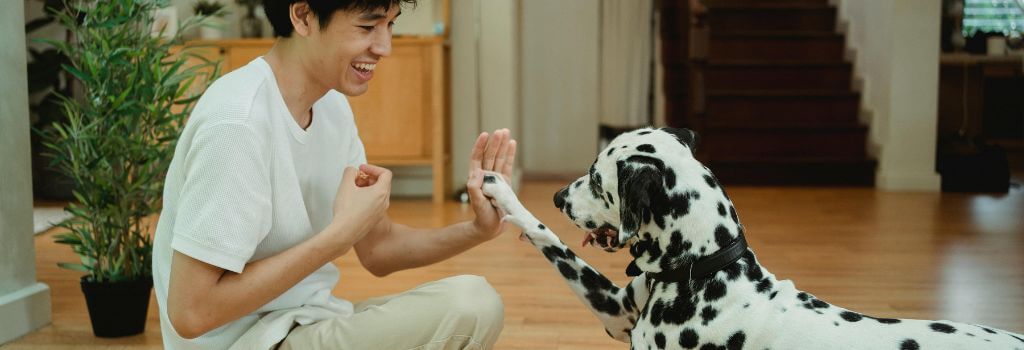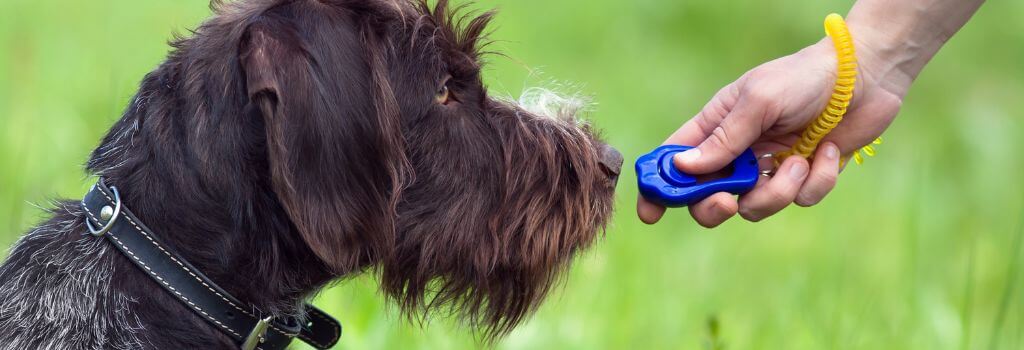If you've ever tried to train your dog and thought, “There has to be a better way than constant correction,” you’re not alone. Many dog owners have been embracing different training techniques that focus on building trust and rewarding good behavior rather than punishing mistakes, like positive reinforcement.
Positive reinforcement dog training offers a science-backed approach that helps dogs learn without fear, punishment, or confusion. In this post, we'll explore positive reinforcement, why it works, how it compares to traditional training, and how to get started with your dog.
What Is Positive Reinforcement? Why Does It Work?
Positive reinforcement training involves rewarding your dog for the things they do right. The reward could be a toy, a game, or a treat — whatever your dog wants to work for. The goal with positive reinforcement dog training is to increase the frequency of the desired behaviors and help the dog create positive associations with them.
During training, a focus on rewards influences dog behavior and teaches dogs to love training. Positive reinforcement is all about earning the good stuff. Without fear of doing the wrong thing, your dog can actively participate in the training process. Here’s the science behind it:
You may have heard of Pavlov and his dogs. Remember, the dinner bell rang, and the dogs salivated. In this study, dogs learned to associate the bell with the coming food, so they were drooling with anticipation, even before their meal arrived. This cause and reaction is known as classical conditioning or associative learning. And in actuality, this is happening with your dog all the time. For example, when your doorbell rings, your dog gets excited (or not) because they anticipate a visitor on the front stoop. They have learned to associate the ringing bell with people outside the door.
But this type of training happens involuntarily. So what about all the active training you do with your dog? That’s where operant conditioning comes in. Also known as trial-and-error learning, this is when dogs learn to associate their behavior with its consequences. When this type of training is successfully utilized, dogs increase the frequency of behaviors with pleasant consequences and decrease the frequency of those with unpleasant consequences.
Let’s make this more relatable — your dog barks at you while you’re busy (on the phone, working, etc.), and you give them some treats or toss them a toy to keep them quiet. The goal, of course, is to make your dog stop barking while you are busy, but you have given your dog something they enjoy (a pleasant consequence while they were barking), so now your dog is likely to bark again next time you are busy. On the opposite end, if your dog bothers the cat and the cat scratches their nose, they’ll think twice about bothering the cat in the future. The scratch was an unpleasant consequence.

When applying this to your home, the process of positive reinforcement training is effective because of the psychological responses that come from your pets.
- The behaviors you want to see more of → introduce pleasant consequences
- The behaviors you want to see less of → introduce unpleasant consequences
Positive Reinforcement Dog Training vs. Traditional Dog Training Methods
The Use of Tools
- Positive training uses rewards, motivations, and guidance to train and change a dog’s behavior. This might include the use of food, treats, toys, play, attention, and opportunities to sniff and explore.
- Traditional training uses intimidation, fear, physical actions, and pain to change behavior. This might include leash jerks, collar corrections, spraying with water or citronella, hitting, poking, kicking, using prong collars, hanging by the collar, or using an electric shock.
The Process of Learning & Teaching
- Positive training teaches dogs what to do, which sets the dog up to succeed because they are guided and taught to do what the person wants.
- Traditional-based trainers tend to wait for the dog to exhibit the unwanted behavior and then punish him. This sets them up to fail from the outset; although it might teach the dog what not to do, it doesn’t tell the dog what the person or trainer wants instead.
Understanding The Behavior at Its Core
- Positive reinforcement training involves finding the underlying cause of a behavior problem, such as anxiety or fear, and changing how a dog feels to help alter the dog’s behavior permanently, not just in that moment.
- Traditional training methods don’t usually emphasize this. Punishment almost always actually makes the dog’s insecurity even worse while decreasing the dog’s ability to learn.
Common Tools Used in Positive Reinforcement Training for Dogs
1. Treats and Treat Pouches
Food is a great reinforcer, as most pet parents know. Some dogs are happy to work for just about anything, even the blandest, most boring food options (we’re looking at you, Labradors), but many dogs will only work more attentively for higher-value treats. Either way, a treat pouch comes in handy during training sessions. The pouch allows you to have a secure way of storing food and keeping your hands free for your dogs.
2. Enrichment Toys
Enrichment toys for dogs are great boredom busters and a nice way to help your dog learn to “sit quietly and color” when you’d like to relax. Some dog favorites include KONG products, puzzle bowls, and puzzle toys. Puzzle bowls are also beneficial in slowing down quick eaters, which may not seem like active training, but they actually help prevent unwanted behaviors.
3. Crates, X-Pens, or Baby Gates
Even if you don’t plan to use a crate, training your dog to comfortably accept crating will make vet and grooming appointments less stressful, as dogs often need to be crated or otherwise confined as part of those visits.
4. Chew Toys
Chewing is natural for dogs, so it’s important to provide plenty of appropriate chew items and to help your dog build value for self-entertaining through a relaxing chew session. Chew items like Kong toys and the Zogoflex line of toys by West Paw, as well as durable Nylabones and Benebones, are great choices to introduce this behavior for dogs.
Note: Durable chews like Nylabones and Benebones are made of nylon and are non-edible. As dogs chew, their teeth wear the bone down, but they should never be able to bite through the bone. Many vets, especially dental vets, advise against these types of tough chews due to the possibility of an aggressive chewer breaking a tooth.

5. Clickers, Whistles, Long Lines
Clickers are used as a “bridge,” i.e., to connect a situation with a consequence. Example: your dog is looking at another dog, and you want them to look back at you for a treat. In this situation, your dog sees the other dog, you *click*, and your dog looks at you (which you then reward). The clicker is an association tool that is eventually meant to be phased out of training.
Whistles are a different form of a clicker and are traditionally used in longer distances, such as outdoor recall training.
Long lines are longer leashes. Long lines are a great tool for teaching leash walking skills, recall, and voluntary responses with distractions. Utilizing long lines is a great step after initial behavior training.
In addition to the tools listed above, traditional training may also include:
- Choke chains: These metal collars tighten around a dog’s neck when the leash is pulled. They are intended to stop pulling, but can cause injury and stress if misused or overused.
- Slip leads: Often used by trainers and shelters for quick handling, slip leads function similarly to choke chains and can put pressure on the trachea.
- E-collars (shock collars): These use electrical stimulation to correct unwanted behaviors. Some trainers use these with a remote to “fine-tune” behaviors, but misuse can lead to anxiety, pain, or even aggression.
How Does Positive Reinforcement Dog Training Help My Dog Day-To-Day?
Using positive reinforcement for your dogs has numerous benefits. It helps boost your dog’s confidence and trust while also encouraging a fun and rewarding learning environment. The longer you utilize positive reinforcement techniques with your dog, the stronger your bond will grow, and you will reduce the risk of behavioral problems occurring down the line.
Here are some ways you can begin implementing positive reinforcement every day:
- Begin giving your dog a choice
- Identify the behaviors you want your dog to be doing and begin rewarding for them
- Choose various rewards — for harder behaviors (such as staying calm in high-traffic areas), you may want a higher-value reward
- Start small with simple behaviors and short training sessions and gradually increase the difficulty.
- Remember to stay consistent! Lack of consistency can be confusing to your dog.
First Things First: Talk to Your Veterinarian
Before jumping into any training method — positive reinforcement or otherwise — your first step should be a visit to your veterinarian, especially if you’re dealing with behavior changes or challenges.
Many behavioral issues stem from underlying medical causes like pain, hormone imbalances, or cognitive dysfunction, and these must be ruled out first. A dog that’s suddenly aggressive, fearful, or destructive may not be "bad" — they may be unwell.
Even if a medical issue isn't at play, your vet can be an incredible resource. Many veterinary clinics are well-connected with certified dog trainers, behaviorists, or veterinary behavior specialists in your area. Your vet can help guide you to reputable resources and recommend next steps based on your dog’s unique situation.
When to Ask a Professional Dog Trainer for Help
Dog behavior is ever-evolving. As your dog grows year by year and has new experiences every day, their behavior is bound to change. You will be able to tackle most behaviors on your own, but there are times when you might need outside help.
- If you are suddenly unable to leave your dog alone and they are tearing apart your home, possibly injuring themselves, or urinating after years of no issues, then it is time to seek help! Your veterinarian is a great first stop to confirm or eliminate a medical issue and be able to point you in the right direction for working with a behaviorist.
- If your once calm dog is suddenly biting and snapping at everyone and everything, it’s time to seek help! Changes in behavior can happen from underlying medical conditions, and a sudden change to extreme behavior is never one to ignore.
Positive reinforcement isn’t just about treats — it’s about teaching, communicating, and connecting with your dog. When we shift away from punishment and into a mindset of support and guidance, our dogs thrive — and so do we. Training is a journey, not a destination. Start small, stay consistent, and don’t be afraid to ask for help. Your dog will thank you for it.
Don't have a vet in your area yet? We can help you find a local veterinarian.
If you have more questions, the GeniusVets Teletriage platform will give you unlimited access to text and/or video calls with board-certified veterinarians! To learn more click here.


The Ultimate Guide
to Dog Care
This free guide is an indispensable manual for dog ownership. Filled with veterinary advice and recommendations on every important topic at each stage of your dog’s life, this is all the stuff that responsible dog owners need to know. That is why we are making it free!
